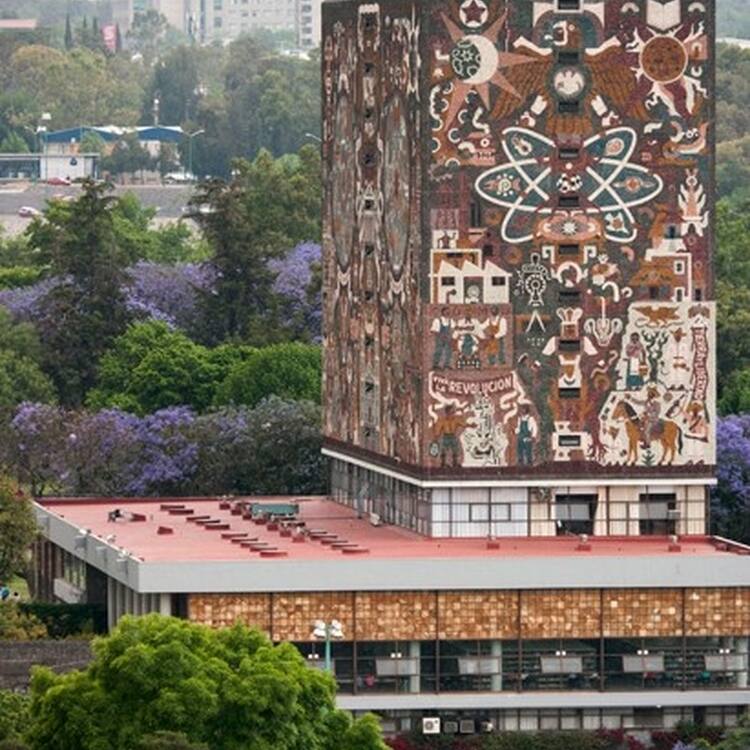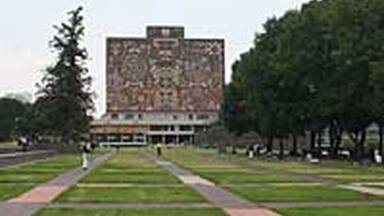Campus central de la cité universitaire de l’Universidad Nacional Autónoma de Mexico (UNAM)
Central University City Campus of the Universidad Nacional Autónoma de México (UNAM)
The ensemble of buildings, sports facilities and open spaces of the Central University City Campus of the Universidad Nacional Autónoma de México (UNAM), was built from 1949 to 1952 by more than 60 architects, engineers and artists who were involved in the project. As a result, the campus constitutes a unique example of 20th-century modernism integrating urbanism, architecture, engineering, landscape design and fine arts with references to local traditions, especially to Mexico’s pre-Hispanic past. The ensemble embodies social and cultural values of universal significance and is one of the most significant icons of modernity in Latin America.
La description est disponible sous licence CC-BY-SA IGO 3.0
Campus central de la cité universitaire de l’Universidad Nacional Autónoma de Mexico (UNAM)
Le campus qui est constitué d’un ensemble de bâtiments, d’équipements sportifs et d’espaces ouverts dans la zone méridionale de Mexico a été construit entre 1949 et 1952. Plus de 60 architectes, ingénieurs et artistes ont travaillé au projet. Le campus est un superbe exemple du modernisme du XXe siècle, il illustre l’intégration de l’urbanisme, de l’architecture, de l’ingénierie, de l’architecture de paysage et des beaux-arts et leur association avec des références aux traditions locales, notamment le passé préhispanique du Mexique. L’ensemble incarne des valeurs sociales et culturelles de portée universelle. Reconnu dans le monde entier, ce campus est l’un des grands symboles de la modernité en Amérique latine.
La description est disponible sous licence CC-BY-SA IGO 3.0
حرم الجامعة الوطنية المكسيكية المستقلة (يونام)، مكسيكو
يشكل الحرم الجامعي مجموعة من المباني والمرافق الرياضية والمجالات المفتوحة في جنوب مدينة مكسيكو، وقد بني بين عامي 1949 و1952 لضمّ الكليات والمرافق الجامعية في مكان واحد، وتحسين نوعية حياة الأسرة الجامعية. عمل أكثر من ستين مهندساً معمارياً ومهندساً وفناناً على هذا المشروع. فبات حرم الجامعة الوطنية المكسيكية المستقلة (يونام) يشكل مثالاً فريداً للحداثة في القرن العشرين، من خلال دمج مجالات التخطيط المديني والهندسة المعمارية والهندسة وتصميم المشاهد الطبيعية والفنون الجميلة، في ظل إبراز التقاليد والمرجعيات المحلية، لا سيما بالعودة إلى ماضي المكسيك قبل وصول الإسبان. ويحوي الحرم قيماً اجتماعية وثقافية ذات دلالات عالمية. يمثل الحرم الجامعي محط إعجاب عالمي ويُعدّ من أبرز معالم الحداثة في أميركا اللاتينية. كما أنه يمثل أحد المشاريع النادرة عبر العالم التي جرى من خلالها تطبيق المبادئ المقترحة من جانب حركات الحداثة في مجال الهندسة المعمارية وتخطيط المدن بهدف تحسين نوعية حياة الناس.
الشعب إلى الجامعة والجامعة للشعب رسالة اليونسكو (2007)
source: UNESCO/CPE
La description est disponible sous licence CC-BY-SA IGO 3.0
墨西哥国立自治大学大学城的核心校区
墨西哥国立自治大学大学城的核心校区集中了校舍、体育设施和开阔地,建于1949年至1952年,60多名建筑师、工程师和艺术家参与了这项工程。校园体现出独特的20世纪现代风格,融合了城市化、建筑、工程、景观设计和艺术,同时借鉴了当地传统,特别是前西班牙殖民统治时期的历史沿革。校园具备突出的社会和文化价值,获得广泛赞许,并跻身拉丁美洲最重要的标志性建筑之一。现代建筑和城市规划原则的最终目标是提升居民的生活质量,纵观全球,能够全面落实这些原则的建筑工程为数寥寥,墨西哥国立自治大学的大学城就是其中之一。
source: UNESCO/CPE
La description est disponible sous licence CC-BY-SA IGO 3.0
Центральный университетский городок Государственного автономного университета Мехико
Центральный университетский городок Государственного автономного университета Мехико (UNAM) построен в период c 1949 по 1952 гг. Восхитительный образец модернизма XX в., иллюстрирующий взаимопроникновение урбанизации, архитектуры, строительной технологии, пейзажной архитектуры и искусства их сочетании с элементами мексиканских традиций, относящихся к эпохе, предшествующей испанской колонизации. Он является воплощением общечеловеческих социальных и культурных ценностей. Всемирно известный университетский городок - это один из выдающихся символов латиноамериканского модернизма, а также один из единственных проектов в мире, в полной мере воплотивших такой принцип современной архитектуры и урбанизма как повышение уровня жизни людей.
source: UNESCO/CPE
La description est disponible sous licence CC-BY-SA IGO 3.0
Campus central de la Ciudad Universitaria de la Universidad Nacional Autónoma de México
Edificado entre 1949 y 1952, el campus central de la Universidad Nacional Autónoma de México (UNAM) está integrado por un conjunto de edificios, instalaciones deportivas y espacios abiertos situado en la zona sur de la capital mexicana. El proyecto de su construcción fue ejecutado por más de 60 arquitectos, ingenieros y artistas. El resultado fue la creación de un conjunto monumental ejemplar del modernismo del siglo XX que integra el urbanismo, la arquitectura, la ingeniería, el paisajismo y las bellas artes, asociando todos estos elementos con referencias a las tradiciones locales, y en particular al pasado prehispánico de México. El conjunto encarna valores sociales y culturales de trascendencia universal y ha llegado a ser uno de los símbolos más importantes de la modernidad en América Latina.
source: UNESCO/CPE
La description est disponible sous licence CC-BY-SA IGO 3.0
メキシコ国立自治大学(UNAM)の中央大学都市キャンパス
メキシコ・シティ南部にあるメキシコ国立自治大学は、敷地面積約7k㎡を誇る中南米最大規模の大学で、1551年に新大陸に建てられた最初の大学の一つ。1949年から1952年にかけて、60人以上の建築家や技術者、芸術家を動員して数々の建築物が建てられ、現在のような都市の様相を呈するに至った。キャンパス内には、巨大な壁画が描かれた中央図書館や大学本部塔をはじめ、オリンピックスタジアムや博物館、美術館などが集中する。メキシコの近代建築とディエゴ・リベラを筆頭とする世界的に著名な芸術家が手がけた壁画などが融合したキャンパスは、メキシコ革命後の近代化運動を反映する都市建設の好例である。source: NFUAJ
Stadscampus van de centrale universiteit Universidad Nacional Autónoma de México (UNAM)
De campus van de centrale universiteit – een geheel van gebouwen, sportfaciliteiten en open ruimten – werd tussen 1949 en 1952 gebouwd met behulp van meer dan 60 architecten, ingenieurs en kunstenaars. Als gevolg hiervan is de campus een uniek voorbeeld van het 20e-eeuwse modernisme in postrevolutionair Mexico, dat stedenbouw, architectuur, bouwkunde, landschapsontwerp en beeldende kunst integreert. Met verwijzingen naar lokale tradities, in het bijzonder het pre-Spaanse verleden van Mexico. Het universiteitscomplex getuigt ook van modernisering in de context van universele waarden en idealen zoals toegang tot onderwijs, verbetering van levenskwaliteit en een integrale intellectuele en lichamelijke opvoeding.
Source : unesco.nl
Valeur universelle exceptionnelle
Le campus central de la cité universitaire de l’UNAM témoigne de la modernisation du Mexique post-révolutionnaire dans le cadre des valeurs et idéaux universels concernant l’accès à l’éducation, l’amélioration de la qualité de vie, l’éducation complète sur les plans intellectuel et physique et l’intégration entre l’urbanisme, l’architecture et les beaux-arts. Il constitue une création collective pour laquelle plus de 60 architectes, ingénieurs et artistes ont travaillé ensemble dans le but de créer les espaces et équipements susceptibles de contribuer au progrès de l’humanité par le biais de l’éducation.
L’urbanisme et l’architecture du campus central constituent un exemple exceptionnel de l’application des principes du modernisme du XXe siècle fusionnés avec des éléments issus de la tradition mexicaine préhispanique. Cet ensemble est devenu l’une des plus importantes icônes de l’urbanisme et de l’architecture modernes en Amérique latine, reconnue universellement.
Critère (i) : Le campus Central de la cité universitaire de l’UNAM est un exemple unique au XXe siècle d’une œuvre à laquelle plus de 60 professionnels ont participé dans le cadre d’un plan directeur en se fixant pour but de créer un ensemble architectural urbain qui témoigne de valeurs sociales et culturelles de portée universelle.
Critère (ii) : Les tendances les plus importantes de la pensée architecturale du XXe siècle convergent sur le campus central de la cité universitaire de l’UNAM : l’architecture moderne, le régionalisme historiciste et l’intégration plastique, ces deux derniers étant d’origine mexicaine.
Critère (iv) : Le campus central de la cité universitaire de l’UNAM est l’un des rares modèles existant dans le monde où les principes proposés par l’architecture et l’urbanisme modernes ont été pleinement appliqués, dans le but ultime d’offrir à l’homme une remarquable amélioration de sa qualité de vie.
Étant donné que les éléments physiques fondamentaux de l’ensemble d’origine sont toujours présents et qu’aucune modification majeure n’a été apportée, le bien répond aux conditions d’intégrité et d’authenticité. Les éléments physiques essentiels du campus sont restés inchangés : tracé urbain, bâtiments, espaces ouverts, système de circulation et aires de stationnement, conception du paysage et œuvres d’art. Les éléments physiques existants expriment donc les valeurs historiques, culturelles et sociales de cet ensemble, de même que son authenticité en termes de conception, de matériaux, de substance, d’exécution et de fonctions.
Au niveau national, le campus central a été classé monument artistique national en juillet 2005, dans le cadre de la loi fédérale sur les monuments et les zones archéologiques, artistiques et historiques. Au niveau local, le campus central et le stade olympique sont définis comme étant des zones de conservation du patrimoine dans le cadre du programme du district pour le développement urbain (1997) élaboré par la délégation de Coyoacán, l’une des unités administratives de la ville de Mexico. L’université, étant une organisation autonome, a ses propres services en charge de l’entretien et de la conservation du campus. Parmi ceux-ci, le plan de direction de la cité universitaire (1993) régit l’accroissement futur des équipements universitaires, l’utilisation du terrain et l’entretien du campus. Le plan global pour la cité universitaire (2005) est le plan de gestion actuel du campus. Les éléments physiques sont en bon état de conservation et le processus de vieillissement est contrôlé au moyen de plans d’entretien et de préservation pour les espaces bâtis ou non bâtis. Le Bureau des projets spéciaux de la UNAM a élaboré et met en œuvre le plan global pour la cité universitaire (septembre 2005). Afin d’appliquer le plan et d’en assurer le suivi, l’université va instaurer le programme de gestion de la cité universitaire (PROMACU).

 Découvrez les photos de OUR PLACE the World Heritage Collection
Découvrez les photos de OUR PLACE the World Heritage Collection